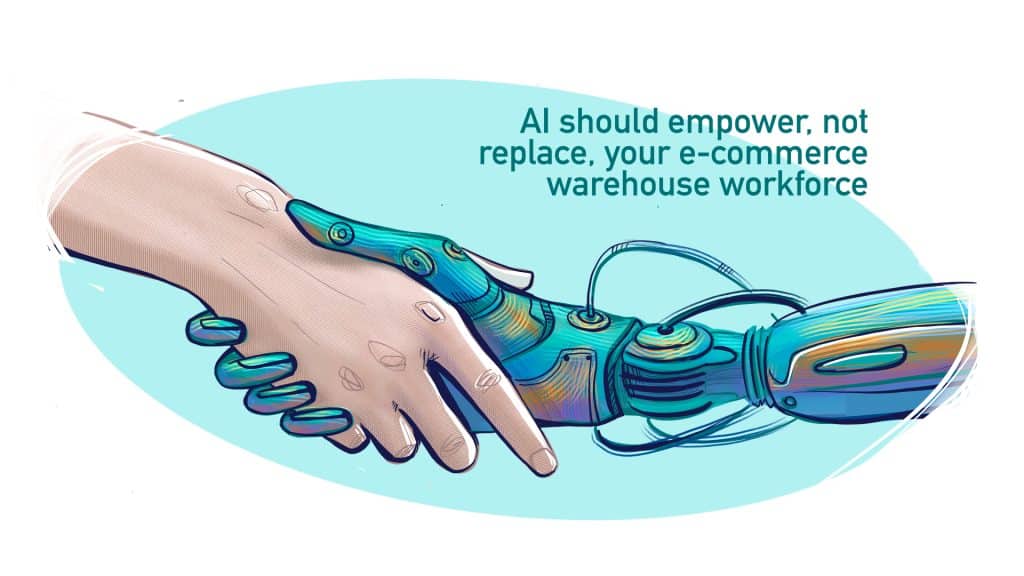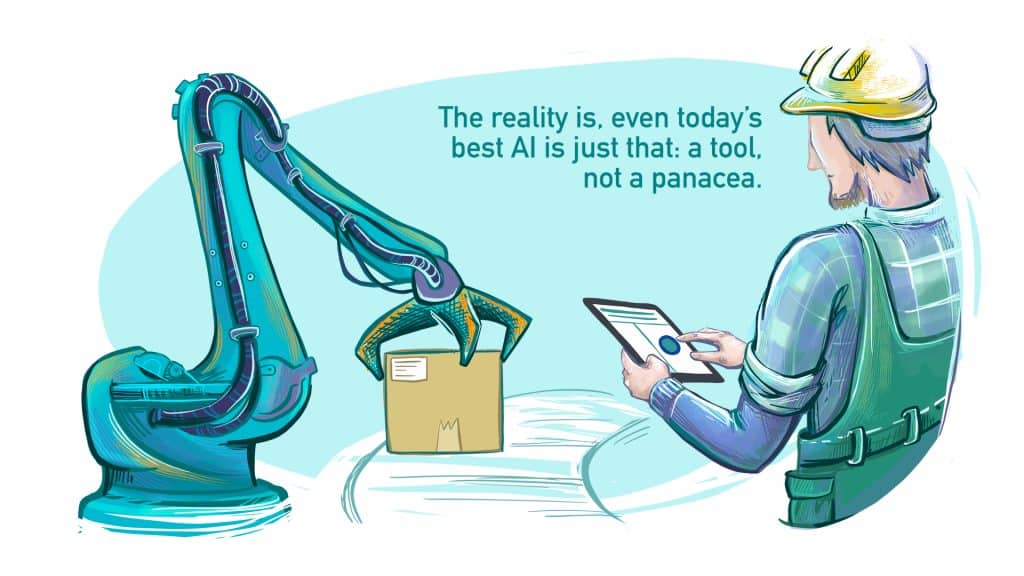
Artificial Intelligence (AI) has entered nearly all aspects of modern life.
Technology has proven itself to be a boon for efficiency and practicality—whether it’s an appliance that can self-diagnose errors, a car that can squeeze itself into any parking space, or a digital assistant on your smartphone that is always at the ready to adjust your thermostat or alert you to an upcoming meeting.
Ecommerce businesses, too, have found themselves increasingly more reliant on AI and its automated algorithms to both streamline and optimize many of the data-driven processes involved in growing a retail company.
One of the primary areas in which AI is being utilized is in the warehouse. It has become increasingly apparent, though, that AI-powered technology is neither a one-size-fits-all solution nor a replacement for a well-trained and efficient warehouse team.
Rather, the most successful implementations of warehouse- and inventory-focused AI happen when technology is utilized to support and maximize the potential of your workforce.
The Growing Role of AI in the Ecommerce Warehouse
AI is becoming a more omnipresent component of many ecommerce SaaS and WMS (Warehouse Management System) products. It is being used to help omnichannel sellers do any number of tasks, including directing picking and sorting, monitoring and assessing performance, devising streamlined workflows, and making cost- and time-optimized shipping and fulfillment decisions.
That said, as more and more businesses turn to technology to optimize their warehouse operations, the pitfalls of over-reliance on or over-hyped expectations of AI-driven software are starting to reveal themselves. Promises of quick spikes in productivity and profits have, in some cases, failed to materialize as quickly as some expected.
While recent studies highlight expectations of 60% or higher return on investment (ROI) in AI technologies over the next five years, 99% of respondents identified challenges when making the most of their AI tools.
When it comes to assessing the ROI of AI-powered warehouse tools, there are a variety of reasons for these types of disappointing results:
- Management fails to fully comprehend how to use and comprehend AI-based systems.
- Warehouse teams lack adequate training with AI-powered tools and workflows.
- Confusion over AI’s role in operational decision-making.
- Improperly configured and/or poorly optimized AI tools.
- A disconnect between AI algorithms and the nuances of existing warehousing needs and workflows.
- Excessive costs associated with tools and features beyond the scope of a particular business.
This is not to decry the value of AI. Its ubiquity and rapid improvement will continue to impact the ecommerce industry. The key is to recognize its ideal value and place within a thriving and growing ecommerce business.
In the logistics and warehousing sectors, specifically, there are tremendous benefits in turning to AI-based support systems that can generate positive, cost-saving benefits daily. The thing to remember is that AI-powered tools are not the cure-all for the challenges facing sub-optimal logistics and warehouse efficiency.
Inventory management and warehouse management are complex processes. They are ever-evolving alongside your ecommerce brand and products.
While data-driven decision-making can be a boon for optimizing these components of your business, you mustn’t lose sight of the workforce that is called upon to actually implement these decisions and protocols.
The human element is often the most overlooked and underestimated component of getting the most out of your AI-driven decision-making. Nevertheless, when the right tools, technology, and data are properly integrated into your business workflows, they can produce noteworthy results.

The Indispensable Value of Synergizing Workers and AI-Driven Technology
While AI is a critical component of an optimized ecommerce warehouse, it is still only a piece of a larger puzzle. While technology can improve the speed and accuracy of many business-related calculations and decisions, it cannot wholly replace the pragmatism, ingenuity, and complexities of the human mind.
Businesses find themselves in trouble when they adopt AI-driven tools, assuming that they will act as a panacea—always producing the best, most actionable directions for sustainable growth and error-free execution.
The reality is that even today’s best AI is just that: a tool. Even with the continued evolution of higher-level AI and robotics, technology is not a full-fledged workforce replacement. On the contrary, technology should exist to make your existing workforce faster, simpler, safer, and more efficient.
Simply providing your warehouse teams with AI-based tools and directions will not revolutionize how your ecommerce logistics work, nor will it lead to overwhelming gains in productivity. For those types of results, your warehouse staff must both understand and buy into the benefits of AI support.
This requires training and time, and it also means considering your staff when making decisions about the ideal roles for AI in your warehouse.
Some questions to ask include:
- Does the AI-based technology address the specific warehouse metrics you seek to improve?
- What training is required for staff at all levels to ensure competence and comfort?
- Is the technology accessible and familiar to your workforce?
- What impact will an increased reliance on AI have on the onboarding process?
- What agency will workers have to address perceived errors or miscalculations by AI-driven tools?
- Will the technology’s role be perceived as a threat or detriment to morale?
The answers to these questions will not only help you decide if you are making the right choices when introducing AI-powered workflows, but they should also be part of an ongoing assessment of the effectiveness and fit of the tools you are adopting.
It is with these principles in mind that we have designed Skublox, our scalable, affordable, and user-friendly sorting system. Skublox allows your logistics team—equipped with simple and familiar technology—to process orders quickly and accurately using an interactive, color-coded light wall.
When an order arrives at your warehouse team, products are scanned and delivered to the corresponding color-illuminated bin. On the other side of the Skublox wall, your shipping team simply scans and packs according to the colors corresponding to their orders.
The end result is a data-driven, intuitive workflow that empowers your workforce rather than replaces it. The technology is easy to learn and use, which reduces onboarding time and costs. It also offers an inexpensive way to both improve fulfillment speed and reduce fulfillment errors, which keeps you and your customers happy.
Strong AI Performance Requires Strong Ecommerce Data
AI is typically programmed to find the most direct pathway between problem and solution based on the available data. When the data is incomplete or inaccurate, problems arise. In an ecommerce warehouse, this can lead to several issues that inevitably hamper efficiency:
- Misplaced stock.
- Miscounted and misrepresented inventory levels.
- Order picking, packing, and shipping errors.
- Mishandled returns.
- Overselling and high backorder volume.
The key to mitigating many of the aforementioned problems is ensuring that you are supplying your AI protocols with the most accurate inventory and business intelligence (BI) data possible. This is where a fully-featured ecommerce inventory management platform like Descartes Sellercloud becomes especially important.
The effectiveness of AI relies upon accurate and up-to-date information. Our software and tools allow you to be sure that your systems and data centers contain all of the most relevant and timely information required to avoid costly delays and errors.
However, even the combination of AI and powerful data-driven protocols will not deliver the strongest possible results without a reliable and empowered warehouse team working in concert. Ideally, technology should be a vehicle for maximizing the productivity of your warehouse staff, not confusing, misusing, or overworking them.
Skustack Lens—an extension of our patented Skustack WMS product—allows your warehouse management team to monitor and track workforce productivity. This can be an affordable and effective way to achieve not only the success of your AI-driven warehouse routines but also the general effectiveness of any of your warehouse workflows.
The Descartes Sellercloud family of omnichannel ecommerce tools are designed to both help grow your business and optimize your team’s workflows. Our numerous AI-driven features enable everyone from management to the floor workers to save time, improve accuracy, boost productivity, and stay safe.
Contact us for a free demo and consultation to see how Descartes Sellercloud’s technologies can simplify and supercharge your online sales today.




